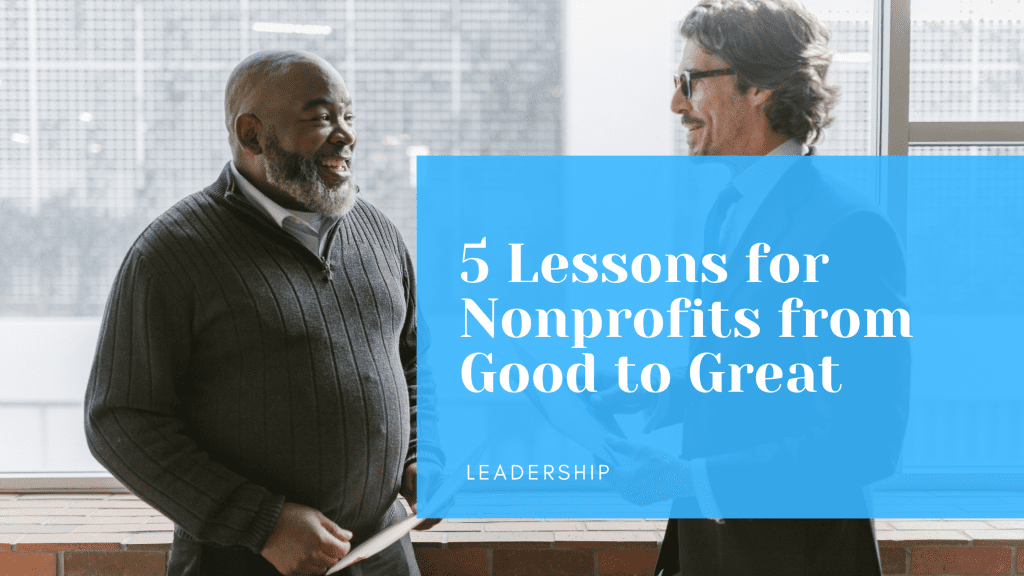In his book Good to Great, Jim Collins lays out a framework that organizations can use to achieve long-term success. Though the book was written with businesses in mind, the principles outlined therein are just as applicable to nonprofits. Here are five key takeaways from Good to Great that fundraising professionals can use to build sustained success for their organizations.
Lesson #1: Get the right people on the bus.
One of the most important lessons from Good to Great is the importance of putting your people first. This means hiring the right people, developing them into leaders, and giving them the autonomy to do their jobs well. As Collins writes, “The good-to-great companies made a habit of attracting superstars and then gave those superstars an enormous degree of freedom.”
Nonprofits need to do the same if they want to attract and retain top talent. This doesn’t mean giving your employees free rein; there still needs to be structure and accountability in place. But it does mean trusting your team members to carry out their roles effectively and empowering them to make decisions without having to go through excessive bureaucracy.
Lesson #2: Focus on what you can be best in the world at.
No organization—no matter how large or well-funded—can be all things to all people. It’s crucial for nonprofits to identify their unique strengths and focus their efforts on becoming the best in the world at what they do. This doesn’t mean neglecting everything else; rather, it means being honest about where your organization’s comparative advantages lie and using those strengths as a foundation upon which to build future success.
 In the world of nonprofits, it’s easy to get caught up in busywork instead of focusing on tangible results. To avoid this trap, Collins recommends that organizations ask themselves two simple questions: “What could we stop doing?” and “What are our three core Values?” He explains that by ruthlessly prioritizing and streamlining your operations, you can free up time and resources to focus on your true mission.
In the world of nonprofits, it’s easy to get caught up in busywork instead of focusing on tangible results. To avoid this trap, Collins recommends that organizations ask themselves two simple questions: “What could we stop doing?” and “What are our three core Values?” He explains that by ruthlessly prioritizing and streamlining your operations, you can free up time and resources to focus on your true mission.
For example, say your nonprofit’s mission is to feed the homeless in your community. You might be tempted to launch programs that provide clothing or job training as well. But if these programs don’t directly contribute to achieving your mission, it might be better to cut them so you can focus on what matters most. Of course, this isn’t always easy—letting go of programs that you’re passionate about is never fun—but it’s necessary if you want your nonprofit to be as effective as possible.
Lesson #3: Create a culture of disciplined people and thought.
The most successful nonprofits are those that have built a culture of discipline and excellence. This starts with hiring self-motivated individuals who are passionate about the organization’s mission and giving them the latitude to do their jobs well. But it also requires having systems and processes in place that ensure quality control and continual improvement. As Collins writes, “You need both brilliant people and madly disciplined execution.”
A big part of being successful is having the discipline to stay focused on your goals and not get sidetracked by shiny objects. This is true for individuals as well as organizations, and it’s something that all great companies have in common. Nonprofits need to build this type of discipline into their culture so that everyone—from the CEO down to the interns—is focused on the task at hand and committed to seeing it through to completion.
Lesson #4: Assess whether you’re really making a difference.
At its core, every nonprofit exists to make a difference in the world. But far too often, nonprofits lose sight of this fact and instead focus on things like raising money or increasing their visibility. While these things are important, they shouldn’t come at the expense of actually making a difference. As such, it’s critical that nonprofits regularly assess whether they’re having the impact they set out to have and make adjustments accordingly.
Lesson #5: Be Willing to Change Direction
One final lesson from Good to Great is the importance of being flexible and adaptable. As Collins writes, “Few things matter more than preserving what you stand for—your core values—while at the same time recognizing that times change and that you must change with them.” In other words, don’t be afraid to change course if you feel like you’re no longer moving in the right direction.
This can be difficult for nonprofits because they often have set goals that they’re required to meet by donors or grantors. But if circumstances change or you realize that your original goal is no longer feasible, it’s important to be willing to adjust accordingly. The last thing you want is to stubbornly stick to a plan that’s no longer working just because you’re afraid of veering off course.
The principles outlined in Good to Great are just as applicable to nonprofits as they are to businesses. By assembled a strong team of self-motivated individuals, focusing on what your organization does best, and creating a culture of discipline and excellence, you can set your nonprofit up for long-term success.



